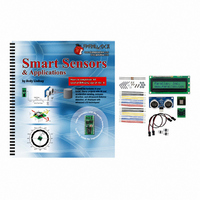28029 Parallax Inc, 28029 Datasheet - Page 217

28029
Manufacturer Part Number
28029
Description
KIT PARTS SMART SENSORS W/TEXT
Manufacturer
Parallax Inc
Datasheet
1.122-28029.pdf
(340 pages)
Specifications of 28029
Accessory Type
Parts Kit
Product
Microcontroller Accessories
Lead Free Status / RoHS Status
Contains lead / RoHS non-compliant
For Use With/related Products
BASIC Stamp® or Javelin Modules
Lead Free Status / RoHS Status
Lead free / RoHS Compliant, Contains lead / RoHS non-compliant
Other names
28029PAR
- Current page: 217 of 340
- Download datasheet (5Mb)
SUMMARY
Activity #1 introduced control characters, techniques for keeping characters inside a
display’s boundaries, and algebra for mapping coordinates to a display. Control character
examples included
MAX
equations to change the values of X and Y coordinates from Cartesian to their Debug
Terminal equivalents.
Activity #2 introduced a means of storing, displaying and refreshing a background
character display image from EEPROM. This is a useful ingredient for many product
displays, and will also come in handy for tilt display and games. An entire display
background can be printed with a
on the
After the
can be used to send the character to the Debug Terminal. For erasing the tracks left by a
character moving over the background, the character’s previous position can be stored in
one or more variables. The previous position information is then used along with the
READ
has moved to its next position.
Activity #3 demonstrated how the accelerometer measurements from Chapter 3 can be
combined with cursor positioning and character recall techniques from Activity #2 to
create a tilt-controlled display. Simple
accelerometer’s x and y-axis tilt. The tilt values were then scaled and offset using
techniques introduced in Chapter 3, Activity #3. The modified
cursor placement for printing the asterisk in the Debug Terminal. The asterisk's position
relative to the Cartesian plane displayed in the background represented the center of the
hot air pocket inside the MX2125's chamber. As the asterisk moved, the background of
its previous location was redrawn using techniques introduced in Activity #2.
Activity #4 introduced tilt-mode game control. The rules of simple games can be
implemented with
the location of the game character to decide what action to take next.
backgrounds can be incorporated into a game by making use of the
optional
EEPROM address at the beginning of a given
operators and an
command to look up the character that should replace the moving character after it
FOR…NEXT
@Address
READ
command loads the next character in the variable, the
loop’s
SELECT...CASE
CRSRXY
operator and Symbol name. Since the Symbol name is actually the
IF…THEN
index
and
technique. Mapping techniques included simple PBASIC
CLRDN
variable to address the next character in the sequence.
FOR…NEXT
statements that use the character in the background at
. Display boundary examples included the
PULSIN
Chapter 5: Accelerometer Gaming Basics · Page 205
loop. A
DATA
measurements were used to measure the
READ
directive, your program can access
command in the loop depends
x
and
y
DEBUG
DATA
values dictated
directive's
command
Multiple
MIN
and
Related parts for 28029
Image
Part Number
Description
Manufacturer
Datasheet
Request
R

Part Number:
Description:
Microcontroller Modules & Accessories DISCONTINUED BY PARALLAX
Manufacturer:
Parallax Inc

Part Number:
Description:
BOOK UNDERSTANDING SIGNALS
Manufacturer:
Parallax Inc
Datasheet:

Part Number:
Description:
COMPETITION RING FOR SUMOBOT
Manufacturer:
Parallax Inc
Datasheet:

Part Number:
Description:
TEXT INFRARED REMOTE FOR BOE-BOT
Manufacturer:
Parallax Inc
Datasheet:

Part Number:
Description:
BOARD EXPERIMENT+LCD NX-1000
Manufacturer:
Parallax Inc
Datasheet:

Part Number:
Description:
CONTROLLER 16SERVO MOTOR CONTROL
Manufacturer:
Parallax Inc
Datasheet:

Part Number:
Description:
BASIC STAMP LOGIC ANALYZER
Manufacturer:
Parallax Inc
Datasheet:

Part Number:
Description:
IC MCU 2K FLASH 50MHZ SO-18
Manufacturer:
Parallax Inc
Datasheet:














